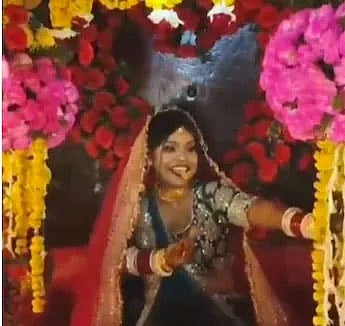Bride leads her own baraat in Prayagraj, fulfilling father’s dream in viral video
Breaking tradition, bride turns father’s dream into moment city can’t stop talking about

Dubai: In a rare and heartwarming twist to tradition, the streets of Kidganj in Prayagraj lit up this week with a sight that left the entire neighbourhood smiling — a bride leading her own baraat (wedding procession).
The moment, captured in a viral video, shows bride Tanu, glowing in her bridal attire, seated gracefully in a beautifully decorated carriage as the procession dances its way to the wedding venue.
The band played, guests cheered, and Baraatis danced around her with the same enthusiasm usually reserved for a groom’s entrance.
But behind this joyous celebration lay a father’s deeply cherished dream.
A father who raised daughters ‘like sons’
Tanu’s father, Rajesh Jaiswal, has no sons. He raised his five daughters with pride, strength and absolute equality. For years, he held on to a quiet dream — to give his daughter a wedding procession as grand and celebrated as any groom’s baraat.
Determined to make it happen, he went all out: He printed a formal baraat invitation, invited neighbours and relatives, arranged a full band and DJ, and ensured the atmosphere reflected pure joy.
A baraat that melted hearts
On the wedding day, Kidganj saw something it had never witnessed before.
Music echoed through the streets. Guests danced without restraint. Children ran alongside the procession. And at the centre of it all was Tanu — smiling, waving, and soaking in every moment as she led her own baraat with elegance.
Locals said it was the first time they had witnessed a bride taking such a procession, calling it “a moment the city will remember.”
But nothing matched the happiness on Rajesh Jaiswal’s face. As he walked behind his daughter’s carriage, watching the dream he held for years come alive, his pride was unmistakable.
A bride leading her baraat may be unconventional — but in Prayagraj that day, it felt perfectly right.
Why the groom traditionally leads the baraat in Indian weddings
1. Cultural tradition
The baraat is traditionally the groom’s grand arrival at the bride’s home, symbolising the start of the marriage ceremony.
2. Symbol of welcome
Historically, the bride’s family welcomes the groom’s party with rituals, garlands and aarti — marking the joining of two families.
3. Celebration of the groom
In many regions, the baraat is considered the groom’s moment of celebration, showcasing his joy and readiness for marriage.
4. Procession with music and dance
Accompanied by a band, dhol, and dancing relatives, the baraat is one of the most energetic, festive parts of an Indian wedding.
5. Changing times
While tradition places the groom at the centre, modern celebrations increasingly reflect equality — with brides joining, dancing with the procession, or, like Tanu, leading their own baraat, redefining the moment with confidence and joy.
Sign up for the Daily Briefing
Get the latest news and updates straight to your inbox
Network Links
GN StoreDownload our app
© Al Nisr Publishing LLC 2025. All rights reserved.
